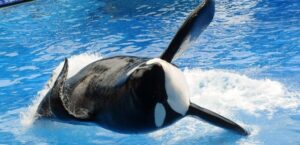Chilling Last Words of Trainer Killed by Killer Whales

Nature can be both awe-inspiring and terrifying. While humans often consider themselves the dominant species on Earth, without the protection of tools and technology we are vulnerable—especially when face-to-face with powerful animals.
This reality was tragically underscored in 1991, when 20-year-old trainer Keltie Byrne lost her life at Sealand of the Pacific in Canada. Byrne, a part-time worker at the park and a marine biology student, was killed in front of stunned colleagues and visitors after falling into a pool with three orcas—two females and a massive male named Tilikum.
The Fall Into the Pool
On that day, Byrne slipped and tumbled into the 26-foot enclosure where the orcas were kept. Almost immediately, the whales prevented staff from pulling her to safety. Tilikum—who had been captured off Iceland in 1983 and shipped to Canada a year later—dragged her under as the others circled.
According to witnesses, Byrne surfaced twice and managed to cry out before being pulled under again. Trainer Karen McGee later recalled hearing Byrne scream her name. “I threw a life ring to her,” McGee said. “She tried to grab it, but the whale wouldn’t let her. To them, it was play. But she was in the water.”
Horrifically, some visitors reported hearing Byrne cry out: “I don’t want to die.”

Tilikum’s Dark Legacy
Byrne’s death forced Sealand to close permanently, with the whales—including Tilikum—eventually sold to SeaWorld in Florida. But controversy followed.
In 1999, the body of a man named Daniel Dukes was found in Tilikum’s tank under mysterious circumstances. Then in 2010, during a performance at SeaWorld Orlando, the orca killed senior trainer Dawn Brancheau in front of a live audience—an event that gained worldwide headlines and led to sweeping changes in marine parks, including the eventual end of SeaWorld’s orca breeding program.
Tilikum himself died in 2017 from a bacterial infection, but his legacy remains both infamous and tragic.
A Stark Reminder
The horrifying death of Keltie Byrne remains one of the most chilling examples of the risks posed by keeping powerful marine predators in captivity. What unfolded in that pool in 1991 changed the conversation about animal welfare and human safety in marine parks forever.